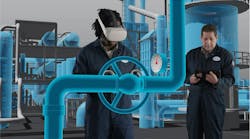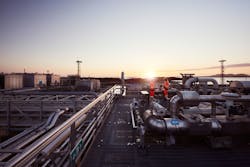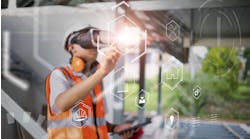As Shell has demonstrated, chemical plants can apply the advanced modeling and visualization techniques in digital twins to improve safety, efficiency and productivity in their facilities.
Shell currently is pursuing a digital-twin innovation and deployment program across the entire company as part of an effort to transform its worldwide operations.
One of its earliest and largest implementations is at the Nyhamna gas processing facility in Aukra, Norway. A hub for processing gas in Europe, Nyhamna exports gas to both the U.K. and mainland Europe.
Norske Shell, based in Rogaland, Norway, is responsible for technical services at the facility and is using Kognifai dynamic digital twin technology from fellow Norwegian company Kongsberg to model Nyhamna’s status in real time.
The initial front-end implementation of the digital twin has taken six months and involved extensive training and demonstrations for the operators.
“It’s a continuous process, with training sessions carried out by either ourselves or experts from Kongsberg when new features or functionality are introduced,” says digital transformation manager Bjarki Guðmundsson.
“We also have identified exceptionally proficient "super users" among our operators and these coach and advise other users, too,” he added.
Among the operator benefits already identified are better situational awareness, faster response times because of access to real-time data, and the ability to carry out more detailed what-if training scenarios.
Modeling for Continuous Improvement
Guðmundsson also points to a “significant”, although commercially sensitive, reduction in maintenance downtime at Nyhamna as potential issues are now far more likely to be caught before they can cause problems.
“Moreover, we have visualized all maintenance data, including notifications, work orders, work permits, and deviations, which helps our work permit coordinator and others have full situational awareness when planning work,” adds Shell’s digital and continuous improvement engineer Arnela Kljucanin.
Training operators on the digital twins’ “cumulative risk view” has helped them to make safer decisions, while the proactive technical monitoring application provides alerts when equipment has moved outside its variable limits, giving early warnings on potential failures to take preventive measures.
“The field visualization and data tools, such as the 3D model and digital documents, have saved us several trips to Nyhamna from abroad for planning work, making our planners more efficient, too,” added Kljucanin.Other chemical companies are benefiting from similar initiatives. For example, one Emerson chemical manufacturing customer is using digital-twin technology to get new hires up to speed more quickly after running into problems finding experienced operators to run a new greenfield plant.
“The company relied heavily on training to bring new personnel up to speed so they could run at peak performance from the moment the plant started up,” says Dustin Beebe, vice president of performance software at Emerson.
“By running training parallel to the project, they also quickly realized operational benefits that would speed start-up and drive better operations,” he says.
Here, engineers used digital twins of production systems to test designs and configuration and to fully train operators before start-up. Using engineering models from AspenTech and Emerson’s Mimic simulation software (the two companies merged in May last year), the project team could rapidly build an operating training simulator (OTS). This allowed them to perform critical project tasks and testing in parallel with training to ensure operators would be ready to go as soon as the plant came online.
Beebe notes that such early implementation of dynamic simulation software has translated to savings of up to six weeks of project time in some scenarios he has been involved with.
Geeta Pherwani, senior manager, product marketing, digital twin and AI at AspenTech cites a project for another chemical manufacturer that used digital-twin simulations to improve the competence of both new and experienced operators. The company implemented a dynamic simulation-based OTS, and used it to train operators for diverse conditions, including start-ups, and shutdowns and to reduce flaring and improve safety.
This ability to both train an operator to perform a task, and to change the way that the operator performs that activity is another key benefit to digital twin training, according to Praveen Sam, director of offering management. Honeywell Connected Enterprise.
He cites the example of a chemical company that struggled to identify causes of yield degradation.
“The digital twin was used to create comparisons of what was happening in the plant and to improve the simulation model,” he says. “So the client could see whether the degradation was an early indication of a process problem, an issue with operator behavior, or both. This way you can identify and deal with issues before they cause a problem.”
Evolving Technologies
Meanwhile, the training experience for operators is constantly evolving as digital twins are integrated with technologies, such as augmented reality (AR) and artificial intelligence (AI).
“The aim is to make these tools intuitive enough so that anyone who can use a mobile device should be able to use the twin,” Kljucanin says. “However, some training is still necessary, especially for new operators, and this typically consists of demos and hands-on training sessions, which can be done remotely or in-person. We find it important to involve different user groups and disciplines in the training sessions to ensure effective adoption of the technology.”
Similarly, as part of the Nyhamna project, the company ran a pilot program last year where it used virtual reality (VR) goggles to train operators in life-saving procedures. “This training material and experience could potentially be connected to the digital twin in the future for new operators’ safety training, among other applications,” she adds.
Pherwani points out that not only are there too few people out there to fill all the operator roles, those that are available want to work in safer and more high-tech positions, with flexibility to work remotely. Hence, the hunt for new, seamless ways to train their employees.
“Software simulators based on digital twins have grown into utilizing AR and VR to expedite learning through an immersive and scenario-based virtual environment,” she says. Operators can now perform multiple scenarios in a simulation environment to imitate high-stress conditions and improve their object recognition.
“Sophisticated technology and automation not only helps plants close the gap created by the people they’ve lost but also helps attract a new generation of workers by making their jobs safer, easier, and more modern,” she adds.
One development because of this is a shift toward more autonomous operation in plants. “Today’s processes are very complex, and it is difficult for operators, especially inexperienced ones, to make quick decisions,” Pherwani says. “One change can cascade across interconnected processes and have a significant impact on safety, reliability and overall efficiency of the plant. Advanced technology reduces the pressure on operators by providing critical actionable insights, and in some cases automating changes.”
Beebe cites the example of a major chemical manufacturer that chose to implement state-based control at one of its plants to make it more autonomous. The project team deployed digital-twin simulation in the cloud to test the state-based control and to train their operators more effectively so they could manage autonomous operations. The digital twin enabled the team to train on abnormal conditions, ensuring their operators could safely monitor and maintain the autonomous operations. The company still has very well-trained operators, but now they work in conjunction with the automation to improve safety and efficiency.
“The impact of improved operator decision-making stemming from better training is significant,” Beebe says. “We have seen customers with an average of three to four incidents per year eliminate all unplanned downtime after implementing OTS. And in one case, a customer leveraged OTS to reduce time to full production by six weeks.”
For Manas Dutta, general manager, workforce excellence at Honeywell Process Solutions, it’s important to remember that the industry is working toward total knowledge. This means part of the digital-twin training strategy should involve the use of historical data to look at different incidents and learn from how people have handled them. “This then becomes the benchmarking baseline,” he notes.
With advanced analytics, this type of comparison can become an industry best practice, he adds. Dutta believes that advanced analytics also will have an impact on predicting human behavior by eliminating avoidable errors.
“Near misses can be analyzed to understand how human behaviors are contributing to such errors,” he explains. “This data in turn can be used as a prediction model in the simulation so that the workforce is trained using these insights, too.”
Another development driven by data analytics is alarm benchmarking. Here, plants analyze historical data from their systems to identify a benchmark – typically the best episode/golden batch – which is then used to compare with operator performance. “This is used objectively to assess where the workforce needs more training,” Dutta added.
Lessons Learned
As the chemical industry builds up its experience with digital twins, important insights are emerging about how to ensure the technology has maximum impact on operations.
Norske Shell’s Guðmundsson believes that a digital twin must be designed with the end users in mind. This, he says, makes them feel part of the process and leads to better adoption of the tool and its increased usage. Part of this involves having a user-friendly interface, too.
“Finally, and crucially, the company taking ownership of the tool is key to successful implementation and adoption. Then it becomes a part of their daily operations, and they feel responsible for its success,” he says, adding that by focusing on these three points Norkse Shell had a much-improved experience at Nyhamna.
Pherwani emphasizes that simulation is continually becoming more accessible – far removed from the first principles knowledge needed in the not-so-distant past. “At the same time, hybrid models that combine machine learning and first principles deliver a comprehensive and accurate model more quickly and without requiring significant expertise, while streamlined workflows accelerate dynamic model development using existing steady state models,” she notes.
The best outcomes are attained by organizations that combine the optimal hardware, software and services tailored to their needs and budget.
“Simulation models can be stored in the cloud, empowering thousands of users to securely access them anytime from anywhere, which significantly reduces the upfront costs required to create and store multiple models,” Pherwani concludes.
For Beebe, integration between the systems modeling the process side – where things are running – and the automation side is essential. Having simulation models within the control system means the tools teams use to build control algorithms are the same software and tools they are using to build the simulation and test the process. Simulations built this way are easier to configure and more effective for teams to use, both for training and for what-if analysis.
He also cautions against letting the simulation system and the control system diverge over time as operators and engineers make changes and tune controls.
This, he says, is the main reason for excessive long-term costs related to simulation technology. However, gone is the need for costly and time-consuming experts to synchronize the two systems.
“Modern synchronization tools detect changes to the control system and alert the team that the two systems are drifting apart,” he says. “With just a few clicks, the team can easily synchronize any changes to the OTS or other simulation to ensure they reflect the current control system configuration.”
According to Honeywell’s Sam, once there is a full digital twin of a plant and people can access live data about processes, assets and their interrelationships, new value can be unlocked.
“For example, the digital twin can be used to perform optimization through running what-if scenarios or to analyze the impact of a process condition on an asset over its lifecycle,” he explains. “This allows the extension of digital-twin technologies to create value beyond training use cases while also noticeably improving the effectiveness of training.”
For his part, Dutta emphasizes that a digital twin is a place where operators and maintenance technicians get to hear about different situations that don’t happen often, such as shutdowns and fires. “The question is how to bring this learning aspect into our digital twin so that users can practice and be prepared for all plant scenarios,” he explains. “It’s not bookish knowledge – its learning by doing.”
He adds that digital twins allow control room operators and field operators to train and learn together. “In a real-life control room, operators and field operators work together as one team,” he says. “They depend on each other’s actions to complete a task, be it start-up, shut down or any emergency situation handling. But they don’t learn together. To improve the collaboration and teamwork between control room and field operator, it is important that they learn together in exactly the same way as they work in the plant.”




